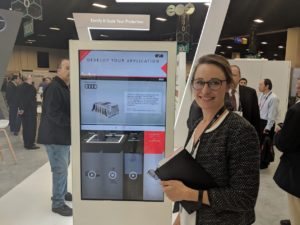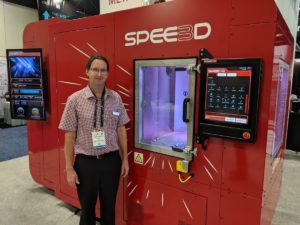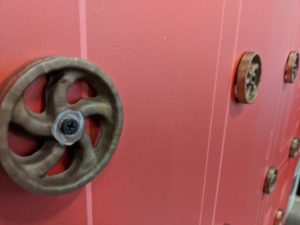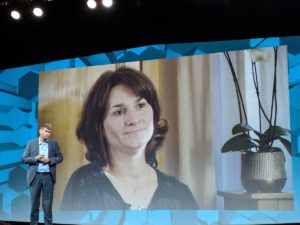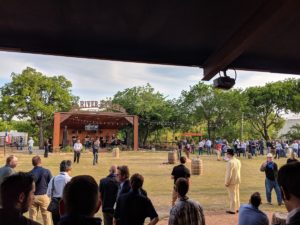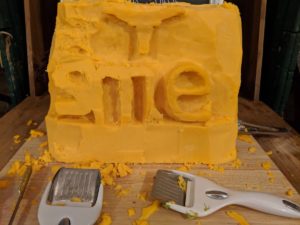 Anticipation is always high for a major event, and RAPID + TCT draws great focus to 3D printing in North America. Several major themes were intentional as this year’s event curated programming centered around medical, metal, and aerospace innovation; others, as they always will, arose throughout the course of the show. This week, writer Sarah Saunders and I were on site in Fort Worth, Texas, as the 3D printing community came together to celebrate technological and business advances — and some friendly armadillo races — for a very busy four days in additive manufacturing.
Anticipation is always high for a major event, and RAPID + TCT draws great focus to 3D printing in North America. Several major themes were intentional as this year’s event curated programming centered around medical, metal, and aerospace innovation; others, as they always will, arose throughout the course of the show. This week, writer Sarah Saunders and I were on site in Fort Worth, Texas, as the 3D printing community came together to celebrate technological and business advances — and some friendly armadillo races — for a very busy four days in additive manufacturing.
From the keynotes to a plethora of interviews and opportunities for conversation, the week was nonstop. As always, the intense scheduling still didn’t leave room to see nearly everything nor to have time to catch up with more than a fraction of attendees. Personally, I didn’t have any time at all to walk the floor outside of dashing to scheduled meetings until the last morning of the show, creating an informed if disjointed impression of whirlwind introductions, showcase projects, and a contagious energy.
With 351 exhibitors and a wealth of workshops, presentations, networking events, and awards, RAPID + TCT 2018 did not leave attendees wanting for interaction. We’ve been following closely with the announcements made at the show, as new 3D printers, materials, and partnerships have been launched; seeing the newest technologies first-hand is invaluable to understanding their capabilities and place in the industry, while the opportunity to catch up with industry influencers is not to be missed.
“It’s always about potential,” Glynn Fletcher, President, EOS North America, told me as we discussed the company’s latest strategic approaches and the growth of the industry.
“Compare RAPID today to ten years ago; then it was more like a flea market, and now it is very important as a vehicle to present ourselves against our competitors. For me, the goal is not to beat the people in this room; the point is with the people in this room, we should be winning business from casting, from foundries, from subtractive manufacturing.”
In noting the necessary stages in collaboration and understanding, Strategic Account Manager Stephanie Kochbeck walked me through EOS’ Additive Mile to demonstrate the step-by-step attention the company pays to the path of scaling up additive manufacturing.
Applications shined large, and a major theme I noticed emerge through conversation and keynote alike was that hardware manufacturers are continually driven by unforeseen applications. As additive manufacturing begins to see a tangible increase in global adoption, real-world applications are driving the industry.
“We spent years in the lab, and it’s now time; the product is ready to move ahead,” XJet Founder and CEO Hanan Gothait said as we sat down to discuss the Israeli company’s latest announcements.
“The industry is at a unique stage in developing 3D strategies. Customers are approaching us with: this is what we want to do, these actual applications. I think it is new, that many companies know what they want to do. We are creating solutions so we can give them what they want exactly so they can do exactly what they want… We want to learn from customers — we always learn and improve, it’s a constant cycle. We listen and really improve on any aspect, printer, material, process, safety, then supply or improve solutions.”
As customers gain awareness of solutions, they are increasingly seeking specific technologies.
 At DWS Systems, which had announced ahead of the event that they would be showcasing their latest 3D printer, Business Development and Key Account Manager Daniela Lavezzi told me that that awareness drew several interested visitors.
At DWS Systems, which had announced ahead of the event that they would be showcasing their latest 3D printer, Business Development and Key Account Manager Daniela Lavezzi told me that that awareness drew several interested visitors.
“People are very interested in this new printer; there have been a lot of visitors, a lot of interest from service centers, from Tiffany, and they came here because they knew we would have this system,” she told me.
In moving from R&D labs to actual customer installations, hardware suppliers are able to better understand real-world conditions and potential uses for their equipment — and what those realities mean for ongoing development.
“There are a lot of technologies out there, so we’re looking at where’s the right sweet spot for our systems. There’s a difference between producing in the lab and for manufacturable process. We’re working with customers on how best to turn the knobs,” Desktop Metal VP of Marketing Ilya Mirman noted.
Metals suppliers, abundant throughout RAPID + TCT as new processes and materials capabilities pick up, frequently brought up the broadening of applications, many of them unanticipated. SPEE3D, which developed its supersonic technology to target full-density commodity metal parts using low-cost materials to compete with casting, has seen global interest in its process.
“We have shipped and are shipping to Germany, Singapore, the US, and Australia; our focus now is to get more machines onto the market,” company CEO and Co-Founder Byron Kennedy told me. “Some are going into research and new markets that we hadn’t thought of. The focus now is getting them into people’s hands and letting them get into uses we hadn’t thought of because we’re a machine manufacturer.”
While manufacturers certainly test for a broad set of applications, they are aware that it will be users’ needs ultimately driving further application development, often in unexpected ways.
“We learn very quickly and test everything we can think of — and that’s only a fraction of what customers will think to do with our systems,” Markforged VP of Product Jon Reilly said, as the company has recently begun shipping its Metal X systems. “We have sensors on everything, so we can learn and get better and better… We’re embarking on that with metal. We’re sharpening focus on best-fit applications.”
Metal solutions were very much in focus as product introductions are increasingly targeted to respond to the needs of customers. After detailing the keys of materials, productivity, and the system (not only machine) focus of the new Arcam EBM Spectra H, Annika Ölme, VP Product Management, Arcam, noted that these factors all show that “we take into account our customer needs” as I spoke with her and Arcam CEO Karl Lindblom.
“Additive manufacturing going forward is really about production; the future is not about prototyping. This is why we are launching this now… It is all growing from a technological standpoint, which is interesting to me as an engineer… There are so many opportunities now to drive the future; the world opens up as we see so much with GE that we can use… It shows that we, and GE Additive, are very serious about driving the additive revolution.”
The emphasis on applications and a growing marketplace was widespread, and Materialise Executive Chairman Peter Leys underscored the importance of showcasing meaningful applications during the morning keynote and in our conversation as well.
“It’s interesting; there are new technologies year after year, and many new players. On one hand this is exciting, and on the other it shows that it is not mature enough. We hear from customers at a show like this that they are even more confused, with so many technologies. What we need is a few technologies that really prove, really showcase technology that makes a meaningful difference. This is not to discourage newcomers; quite the contrary. It is tough to do this without meaningful applications. Hopefully in five years this show will only have booths with reliable, proven technologies that have shown success on the market,” he said before moving on to areas of great importance to Materialise’s strategic focus.
“We have been investing in the medical vertical for a long time now, and every year we are confident we are moving in the right direction as we gain more traction with key partners like J&J.”
- [Image: Sarah Goehrke for 3DPrint.com]
Leys also pointed out that a big part of Materialise’s focus in additive manufacturing is to “build a bridge for the gap” as digital solutions bring about more opportunity for advanced solutions.
“We have never said it was easy; it is our job to make it easy, to build a bridge for the gap, to create solutions. There is a gap. There is a solution, and we make that seamless,” he said.
Awareness of that gap between need and solution is critical for this industry. As a nascent technology, additive manufacturing holds great potential, but awareness does not necessarily lead to adoption. Damage done during previous years of hype left many potential users disheartened at the lack of ease of use; 3D printing is not a just-hit-print solution. More providers are becoming ever more focused on helping to create solutions acknowledging and bridging that gap.
“All that matters, from our perspective, is that there is a huge gap between ideas and prototyping and production. It’s a change for people to learn, to develop,” Greg Ojeda, Co-Founder and CCO of Essentium Materials, told me.
“We use a lot of flowery words, buzzwords like ‘gamechanging,’ but we have real solutions,” Essentium Co-Founder and President Blake Teipel added.
One use case for functional 3D printing showcasing solutions targeted for real-world conditions gaining increasing visibility is HP’s production of more than 140 parts for its Jet Fusion 3D printers that are themselves 3D printed. In Thursday morning’s keynote session dedicated to the future of 3D printing, HP 3D Printing President Stephen Nigro noted that “every part makes business sense” as the team rethought structures to create better components through their own technology.
“We had to be aware and learning,” David Tucker, 3D Print Market Development, Plstics Engineering and Design, HP noted as I caught up on the show floor with HP and Jabil.
“The mindset before had been that there could be no change once a design was locked down,” John Dulchinos, VP Digital Manufacturing, Jabil, added. “3D printing allows us to integrate learning, which is very valuable to manufacturing, to create a better finished part. It’s a powerful journey.”
Scott Schiller, Global Head of Customer and Market Development, HP 3D Printing, continued, “This has been a journey we had to go on to get a population of engineers to think differently, and there are a lot of facets to that. We are definitely still on that journey.”
The journey enabled through agile manufacturing and digital technologies requires an ongoing learning curve, and industry participants are well aware of — and increasingly vocal about — the path toward adoption and maturity. The narrative structure of adoption is compelling in itself, with a journey and monumental gaps to bridge, and it seems to be one leading to a powerful hero’s journey for additive manufacturing.
Throughout RAPID + TCT, emphasis was strong on real-world applications and implications of adopting 3D printing. The technology is growing up and growing in use in terms of both sheer number and breadth of applications.
Also as promised, a quick look into the armadillo races. Winners took home armadillo milk, which is apparently a thing. Races took place during the delightful Texas-themed networking night on the first full day of RAPID + TCT.
- Participants had to blow on armadillos from behind to encourage them toward the finish line
- Yee-haw.
- Who says networking is cheesy?
Networking was a major focus as well and, armadillos aside, opportunities were plentiful and appreciated.
 One milestone event that brought in a fantastic crowd was Wednesday night’s Women in 3D Printing happy hour, co-sponsored by MatterHackers and HP. The event drew more than 40 conference attendees together to a speakeasy-like setting to engage in spirited conversation. Many familiar faces were present, women and men alike, and the next morning several attendees made it a point to note that the introductions gained through the evening were enlightening — and that the mix of attendees provided a nice counterpart to the more typical male-dominated events. More photos from the event can be found here.
One milestone event that brought in a fantastic crowd was Wednesday night’s Women in 3D Printing happy hour, co-sponsored by MatterHackers and HP. The event drew more than 40 conference attendees together to a speakeasy-like setting to engage in spirited conversation. Many familiar faces were present, women and men alike, and the next morning several attendees made it a point to note that the introductions gained through the evening were enlightening — and that the mix of attendees provided a nice counterpart to the more typical male-dominated events. More photos from the event can be found here.
With a wealth of excellent conversations from a very busy week, we look forward to continuing to share insights gleaned from RAPID 2018.
Discuss RAPID + TCT and other 3D printing topics at 3DPrintBoard.com or share your thoughts below.
[All photos: Sarah Goehrke]
Subscribe to Our Email Newsletter
Stay up-to-date on all the latest news from the 3D printing industry and receive information and offers from third party vendors.
You May Also Like
Gorilla Sports GE’s First 3D Printed Titanium Cast
How do you help a gorilla with a broken arm? Sounds like the start of a bad joke a zookeeper might tell, but it’s an actual dilemma recently faced by...
Nylon 3D Printed Parts Made More Functional with Coatings & Colors
Parts 3D printed from polyamide (PA, Nylon) 12 using powder bed fusion (PBF) are a mainstay in the additive manufacturing (AM) industry. While post-finishing processes have improved the porosity of...
$25M to Back Sintavia’s Largest Expansion of Metal 3D Printing Capacity Since 2019
Sintavia, the digital manufacturing company specializing in mission-critical parts for strategic sectors, announced a $25 million investment to increase its production capacity, the largest expansion to its operations since 2019....
Velo3D Initiates Public Offering in a Bid to Strengthen Financial Foundations and Drive Future Growth
Velo3D (NYSE: VLD) has been among a number of publicly traded 3D printing firms that have attempted to weather the current macroeconomic climate. After posting a challenging financial report for 2023,...



